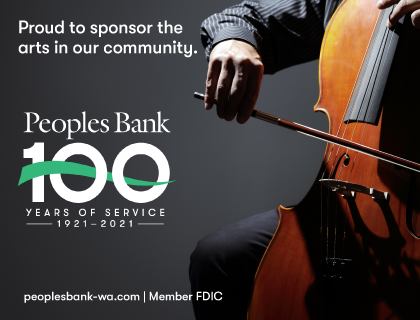
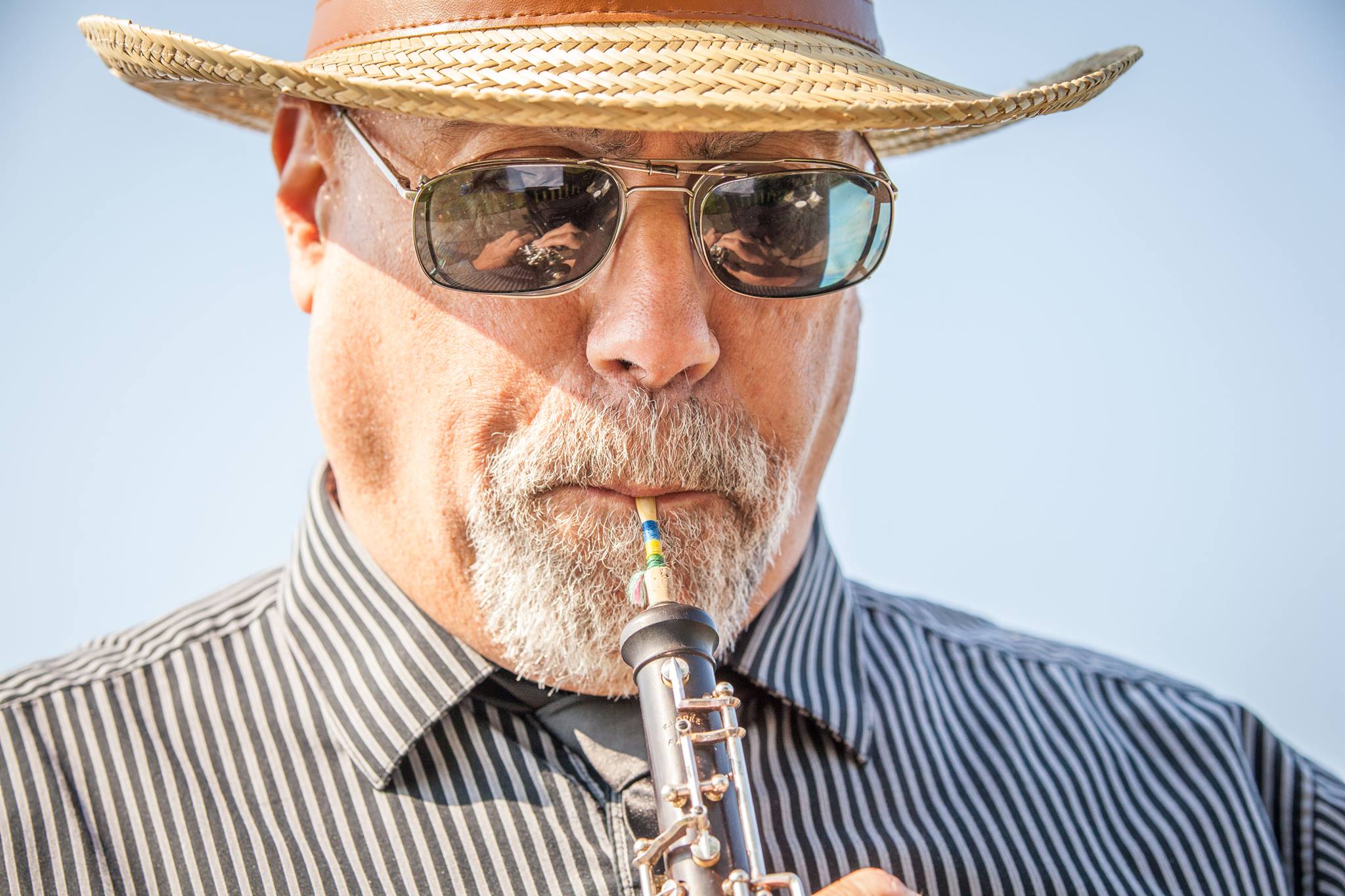
Welcome to the Bellingham Symphony Orchestra’s 46th Season. I am very excited to be serving as the President of the Board during this time, as we return to making music in person at the beautiful Mount Baker Theatre. Playing in the orchestra remains a joy for me as well as serving on the Board of Directors.
While the global pandemic presented many challenges, the resilience and creativity of our musicians, staff, and Board have allowed us to safely move forward this season and resume live performances. The support that we have received from our community during this time made it possible for us to present performances remotely last season, and your ongoing support allows us to continue presenting live performances. Thank you so very much.
We still have a long way to go to get back to pre-pandemic levels of performances and attendance, and I hope we can count on your continued support. Your gift at any level will make a significant impact on our ability to continue to move forward with our plans for the remainder of this season, and to perform for you music that is powerful, beautiful, and inspiring.
Ken Bronstein
President, Bellingham Symphony Orchestra Board of Directors
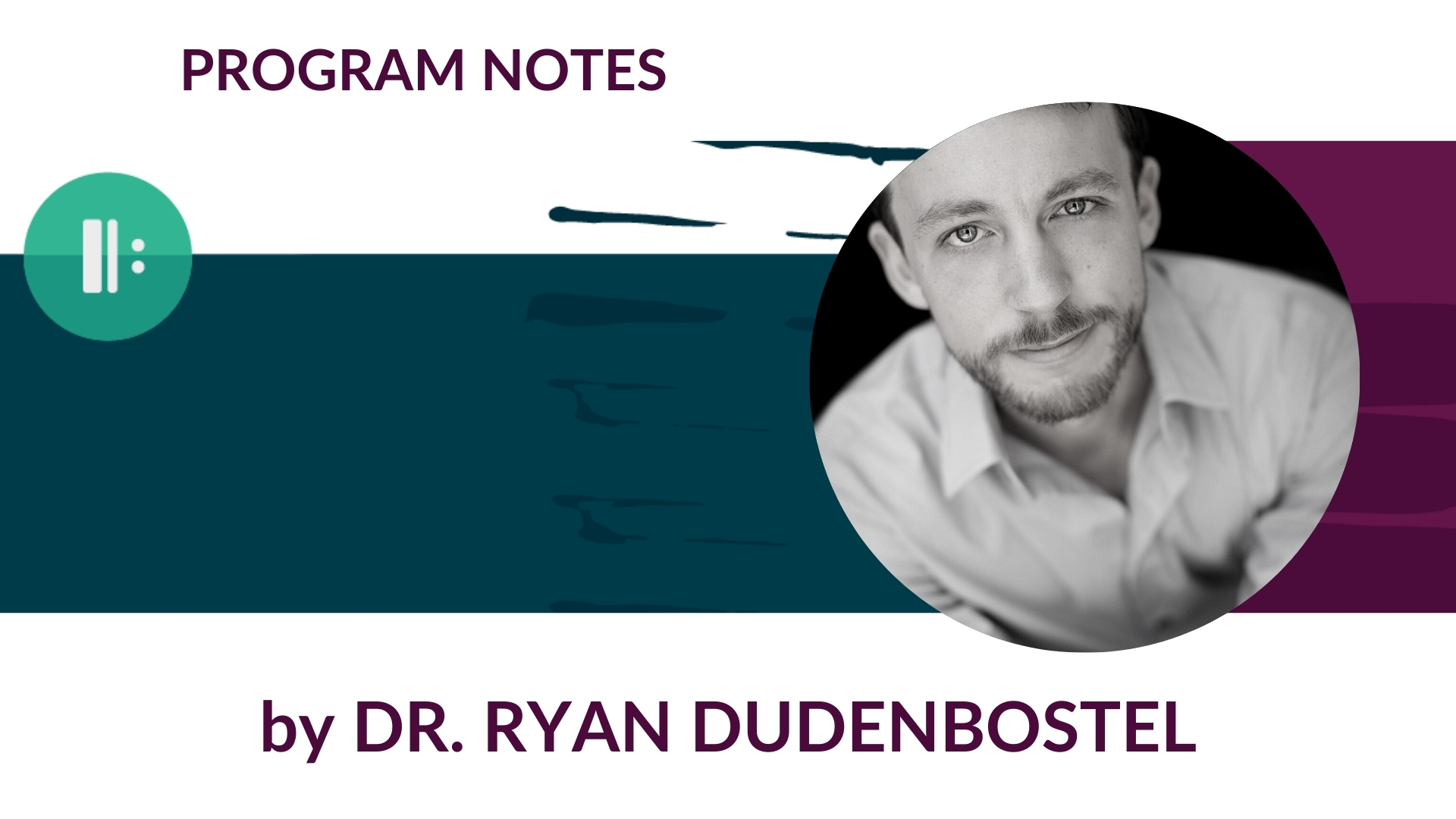
- Chopin composed his First Piano Concerto as a showpiece for himself, and gave the premiere at a farewell concert in Warsaw before moving to Paris.
- The Concerto’s finale is in the style a Krakowiak, a popular national dance in Poland during Chopin’s time.
- Brahms wrote his Fourth Symphony over two summers spent vacationing in the Styrian Alps.
- The finale of Brahms’s Fourth Symphony is a passacaglia, in which a constantly recurring theme is subject to no fewer than 32 variations.
PROGRAM NOTES
Though Ludwig van Beethoven died in 1827, his shadow continued to loom over subsequent composers until well into the twentieth century. In the realms of the symphony and string quartet—genres in which Beethoven demonstrated an almost superhuman command—any new attempt invariably invited unforgiving comparison with the great master. And even after the earned successes of symphonies by Schubert, Mendelssohn, Berlioz, Schumann, and others, the widely held view among critics—and many composers as well—was nonetheless that Beethoven’s symphonic achievements could never be matched, let alone exceeded.
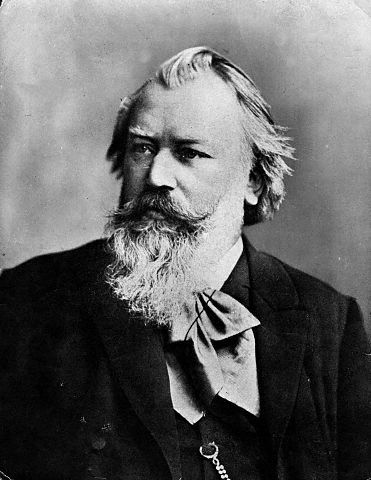
Of all the Romantic composers, perhaps no one was more sensitive to this attitude than Johannes Brahms (1833-1897). Born six years after Beethoven’s passing, Brahms began work on a D minor symphony as early as 1854, upon hearing the elder composer’s legendary Ninth (also in D minor) for the first time. After completing nearly three quarters of the piece, he lost confidence in the work’s merits as a symphony, and repurposed two of the movements in his First Piano Concerto. The third found its way into Brahms’ German Requiem many years later.
Despite encouragement from his publisher, as well as from friends Robert and Clara Schumann, Brahms set his symphonic aspirations aside for nearly two decades. “I shall never write a symphony!” he told Hermann Levi in 1872. “You can’t have any idea what it’s like to hear such a giant marching behind you.” Instead, Brahms focused his attention on “secondary” genres with which he could distance himself from Beethoven’s legacy. Through the composition of serenades, chamber music, choral works, concertos, and the like, Brahms felt able to hone his craft while avoiding the harsh (and primarily self-inflicted) criticism he would have received in response to a symphony or string quartet.
But the elephant in the room was unavoidable, and in 1876 Brahms finally unveiled the first of his four symphonies to the world. The public response was glowing, and cleared the way for his final three installments to come in relatively quick succession: the sun-drenched Second in 1877, the rhapsodic Third in 1883, and finally the steely Fourth in 1885. Brahms composed the piece over the course of two summers spent vacationing in the alpine village of Mürzzuschlag in southern Austria. The piece is remarkably integrated and organic despite its long gestation. Its opening Allegro non troppo commences straight away with a sighing gesture in the strings that becomes the germ for nearly all the music that follows, including vigorous fanfares that remind us of the life and vitality contained in the otherwise darkly hued movement. Beginning with an ominous horn call, the expansive second movement unfolds into a wide-ranging fantasia that is by turns lyrical and defiant. The third movement is a rarity in Brahms: a true, unapologetic, full-throated scherzo bordering on the wildness of Berlioz, and complete with chiming triangle, piping piccolo, and growling contrabassoon. Before the Fourth Symphony’s premiere, the composer circulated copies of the score to a number of trusted friends, all of whom criticized the scherzo as being out of step with the rest of the piece. However, Brahms held to his convictions and retained the movement. Posterity has proven his choice to be the right one; the third movement’s joviality provides the perfect counterbalance to the seriousness of the rest of the symphony.
The finale is as terse and craggy as the scherzo is impetuous. Borrowing an eight-note theme from Bach’s cantata Nach Dir, Herr, verlanget mich (“I long to be near you, Lord”), Brahms turns to a Renaissance form,nthe passacaglia, in which a constantly repeating subject is passed around the orchestra: as a melody, or a bass line, or tucked away secretly among the inner voices. The structural restrictions of the passacaglia prove no barrier to Brahms, as he spins out no fewer than 32 variations of astonishing variety before bringing the symphony to an abrupt, yet decisive full stop.
That Brahms could repurpose his early symphonic efforts into a piano concerto is indicative of his overall aesthetic philosophy: music first, forces second. The exact opposite could be said of his Polish predecessor Frédéric Chopin (1810-1849) and his two piano concertos. These works are pianistic tours de force, a literal catalog of their composer’s advanced techniques, and untranslatable to any other medium.
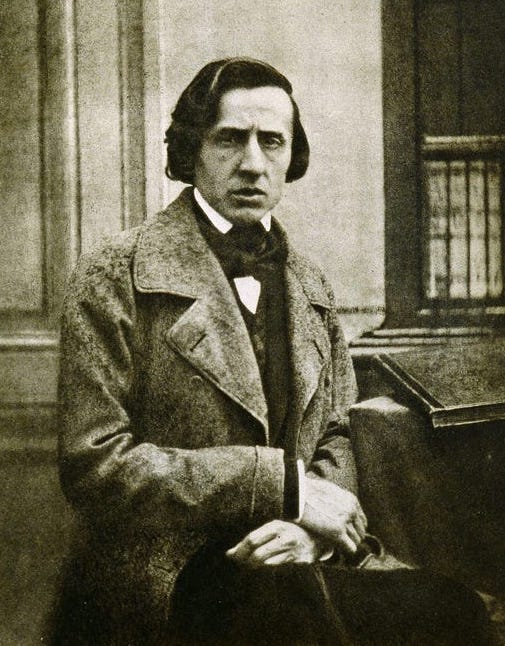
Chopin spent nearly half of his life as an expatriate in Paris, where he was the exotic darling of the most rarefied social circles, demonstrating his singular virtuosity in private salon concerts and teaching piano lessons to the city’s elite class. While at first blush this life may read as frivolous, Chopin’s compositions—like his playing—are anything but. He was an artist of the highest caliber, and used his nearly inhuman technical facility to express musical ideas that were inaccessible to lesser pianists.
Much of Chopin’s most celebrated music comes from this time in Paris, but the pair of piano concertos date from his early years in Poland. In contrast with his Hungarian counterpart Franz Liszt (1811-1886), Chopin had little interest in composing for orchestra; the piano was his language and his life. He wrote his concertos as showpieces for himself, as was the expectation for virtuosos of his day. Consequently, the orchestral accompaniments to these pieces are exactly that: accompaniments. Critics have often lambasted Chopin for his orchestration, comparing him unfavorably to figures like Beethoven and Mozart, who tend to treat the orchestra as an equal conversational partner with the soloist. But in light of Chopin’s priorities—placing the soloist center-stage at nearly all times—his orchestral tailoring reveals an inimitable sensitivity and reserve. Never is the piano overshadowed, but rather supported and colored by the orchestra throughout.
Chopin’s concertos are numbered by publication rather than date of composition; the First Concerto was actually written immediately on the heels of his Second Concerto, and performed in a series of farewell concerts in Warsaw in 1830 before the 20-year-old composer made his westward journey to Paris. Its expansive first movement—with three main themes rather than the typical two—occupies nearly half of the piece’s duration. The central Romanze is disarmingly simple, anticipating Chopin’s later nocturnes. “It is not meant to create a powerful effect,” the composer wrote, “it is rather a Romance, calm and melancholy, giving the impression of someone looking gently towards a spot that calls to mind a thousand happy memories. It is a kind of reverie in the moonlight on a beautiful spring evening.” The brisk finale is set in the manner of a Krakowiak, a popular national dance of the time. Though he never returned to his homeland, this type of Polish influence would surface in Chopin’s music time and time again—most notably in his many mazurkas and polonaises—for the remainder of his life.
Copyright © 2022 Ryan Dudenbostel
Ryan Dudenbostel is the Director of Orchestral Studies at Western Washington University, where he conducts the WWU Symphony Orchestra, coordinates the graduate program, and directs the contemporary music ensemble NowHearThis! Previously, he was Music Director of the El-Sistema-based Santa Monica Youth Orchestra in Los Angeles. He recently served as Interim Artistic Director of the Marrowstone Music Festival, and regularly returns to LA for concerts with the Jacaranda new music series.
![]()
Program notes sponsored by: Garland Richmond & Richard Stattelman
We are so grateful for our generous sponsors!
Season: Peoples Bank & Bellingham Porsche/Audi
Concert: Exxel Pacific
Guest Artist: Louis Auto & Residential Glass
For a full list of BSO's sponsors, please visit our website sponsor page.
Musicians performing in this concert are in bold.
Music Director
Yaniv Attar (bio)
The Jack & Marybeth Campbell Music Director
Violin I
Dawn Posey (bio)
The Garland Richmond & Richard Stattelman Concertmaster
Shu-Hsin Ko
Acting Concertmaster (Assistant Concertmaster)
Heather Ray
Acting Assistant Concertmaster
Emily Bailey
Laura Barnes
David Bean
Gaye Davis
Joanne Donnellan
Irene Fadden
Matt Gudakov
Madeline Massey
Yelena Nelson
Sandra Payton
Krissy Snyder
John Tilley
Karen Visser
Bill Watts
Violin II
Yuko Watanabe
The Debbie & Steve Adelstein Principal 2nd Violin
Heather Ray
Assistant Principal 2nd Violin
Tara Kaiyala Weaver
Acting Assistant Principal 2nd Violin
Linnea Arntson
Liza Beshara
Judy Diamond
Kathy Diaz
Geneva Faulkner
Yoshimi Lin §
Ben Morgan
Lenelle Morse
Audrey Negro
Cecile Pendleton
Carla Rutschman
Joy Westermann
Viola
Morgan Schwab
The Byron & Becky Elmendorf Principal Viola
Eric Kean §
Acting Principal Viola
Katrina Whitman §
Acting Assistant Principal Viola
Virginia Arthur §
Kacey Bradt
Jo Anne Dudley
Alia Kerr §
Natalie Louia
Valerie McWhorter
Michael Neville
Jim Quist
Corey Welch
Cello
Nick Strobel
The Phyllis Allport Principal Cello
Samantha Sinai
Acting Principal Cello
Tallie Jones
The John W. Tilley Jr. Assistant Principal Cello
Brian Coyne
Acting Assistant Principal Cello
Erin Esses Lusk
Noel Evans
Omar Firestone
Jeremy Heaven
Cori Holquinn §
Rebekah Hood-Sava
Barb Hunter
Coral Marchant
Mary Passmore
Bette Ann Schwede
Daniel Watterson
Bass
Mark Tomko
The Charli Daniels Principal Bass
Eirik Haugbro
Assistant Principal Bass
Faye Hong
Anna Jull
Amiko Mantha
Ramon Salumbides §
Flute
Deborah Arthur
The Marcela Berg & Michael Addison Principal Flute
Gena Mikkelsen
Assistant Principal Flute
Piccolo
Gena Mikkelsen
The Carol & Dennis Comeau Piccolo
Oboe
Kristen Fairbank
Co-Principal
Gail Ridenour
Co-Principal
The Ridenour Family Principal Oboe
Ken Bronstein
English Horn
Ken Bronstein
The Dick & Sherry Nelson English Horn
Clarinet
Erika Block
The Gordon & Rosalie Nast Principal Clarinet
Emily Prestbo
David Kappele
Bassoon
Phillip Thomas
The Brian and Marya Griffin Principal Bassoon
Jackson Stewart-DeBelly
Assistant Principal Bassoon
Terhi Miikki-Broersma
Contrabassoon
Phillip Thomas
Taylor Marie Diga-Mocorro §
Horn
Brad Bigelow
The George and Crystal Mills Principal Horn
Jack Champagne
Kristi Kilgore
Greg Verbarendse
Trumpet
Karolyn Labes
The Bill & Leslie McRoberts Principal Trumpet
Del Vande Kerk
Alex Marbach §
Steve Sperry
Assistant Principal Trumpet
Trombone
Phil Heft
The Wendy Bohlke & Brian Hanson Principal Trombone
Brian Thomson
Bass Trombone
Bob Gray
Emily Asher §
Tuba
Mark Lindenbaum
The Marty & Gail Haines Principal Tuba
Timpani
Stephanie L. Straight
Principal Timpani
Percussion
Kay Reilly
Co-Principal
The Valerie McWhorter & Dean Altschuler Principal Percussion
Melanie Sehman
Co-Principal
The Barbara & Michael Ryan Principal Percussion
Jamie Ihler
Harp
Jill Whitman
The Cinda & Stuart Zemel Principal Harp
Keyboard
Andrea Rackl
The Sibyl Sanford Principal Keyboard
§ Substitute
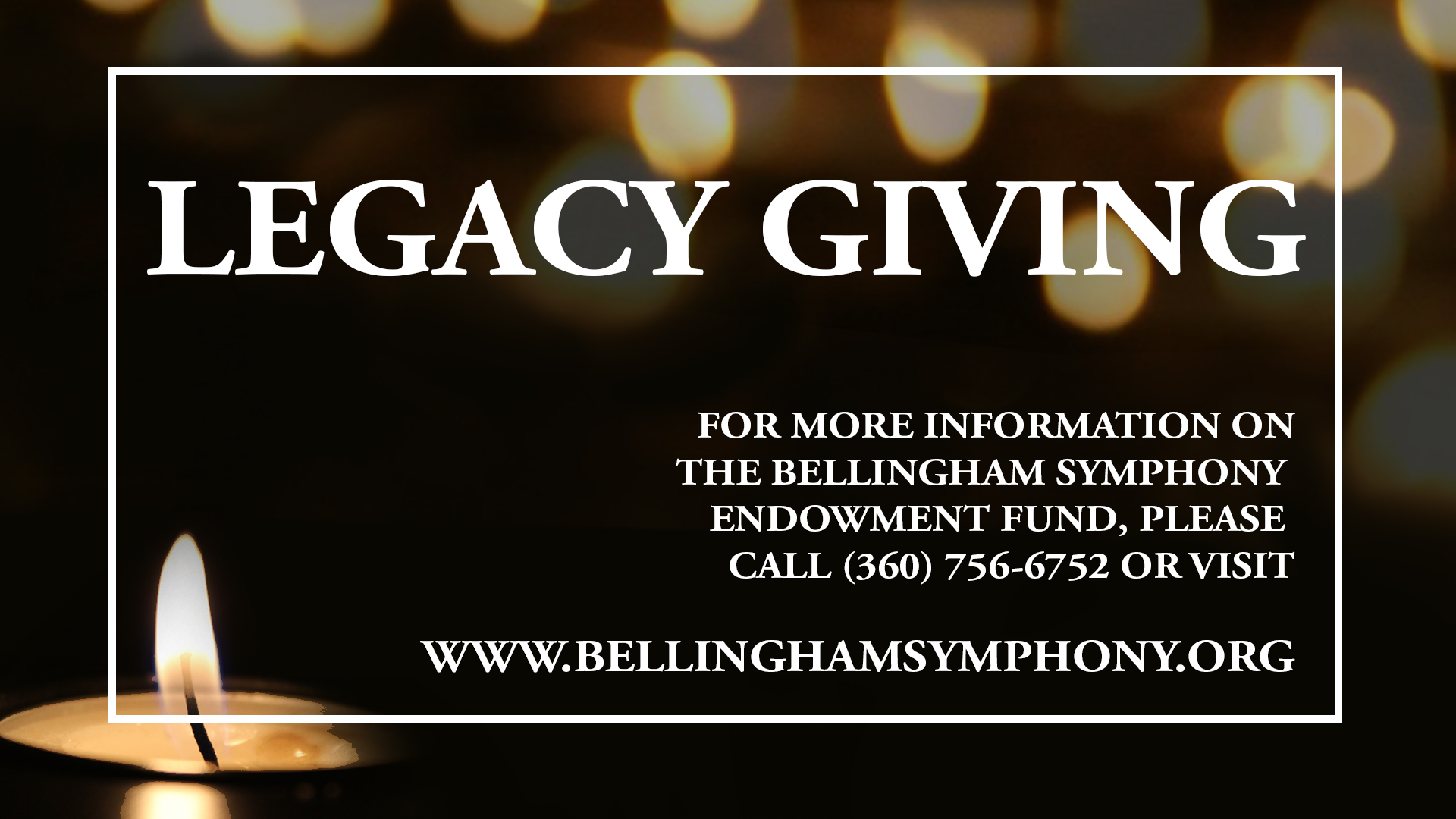
There are many ways to keep the Bellingham Symphony Orchestra’s legacy strong, regardless of your means. We are proud to announce that we now have our own endowment available for legacy giving!
“Our Legacy Society is composed of remarkable, passionate individuals who care deeply about the future of the Symphony and the continuation of our educational programs in the community for years to come.” - Music Director Yaniv Attar
We are so very grateful to our legacy society members, who make it possible for us to keep the music alive, and to encourage musicians of the future. For a list of all our generous contributors and legacy society members, please click here.
For more information, contact us at (360) 756-6752 or by email to executive@bellinghamsymphony.org. You can also see more about ways to give here.
